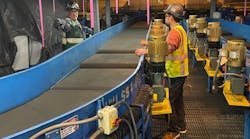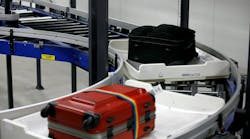Jun. 15—Alaska Airlines passengers flying out of Seattle-Tacoma International Airport won't be waiting in line to check their bags for much longer.
As part of a $2.5 billion initiative, the airline is eliminating its check-in kiosks across the country and replacing them with self-service bag-tag stations. All passengers will be expected to check-in online beforehand, with the ticketing area reserved for those dropping off checked luggage.
The new self-service kiosks have already been installed in one zone of Alaska's Sea-Tac ticketing area, with the rest to be replaced by the end of July.
That's the first element of the SEA Gateway project, a collaboration between the airline and the Port of Seattle, the airport operator, that will remodel the airport lobby to make it less congested for travelers.
Eventually, the airline plans to install a self-service bag-drop station, allowing passengers to not only tag their luggage, but to drop it on the luggage belt.
"When it comes to dropping a bag, that's all [our guests] really want to do — drop a bag," said Amber Simonsen, the company's director of airport transformation. "We want to enable that to the best degree possible."
Simonsen said the process of finding a reservation and printing tags has already been streamlined from "about 3 minutes" to "between 45 and 60 seconds."
With the addition of the bag drop station, the amount of time passengers spend in the lobby will be minimal, she said.
"It really is about creating a consistent experience, creating that ease of flowing through there, because we know travel can be frustrating," she said.
Alaska Airlines is headquartered in Sea-Tac, and the airport is one of its largest hubs. Through April, 3.3 million travelers flew out of Sea-Tac on Alaska flights — just under half of the airport's total traffic, according to Port of Seattle data.
The new check-in came out of a need to process a higher volume of passengers, Simonsen said.
"We are really looking to to grow our airline especially in our hubs, and airports are naturally congested," she said. "What's unique to Sea-Tac specifically, though, is that we really can't expand our footprint there."
Even with the limited ticketing space available at the terminal, the new system will allow Alaska to increase its capacity, Simonsen said.
Self-service bag-tag stations have already been installed at other Alaska hubs, including Anchorage and Portland. At Everett's Paine Field, where ticketing kiosks are used by multiple airlines, plans are to install a similar program for Alaska passengers by the end of this year.
The new bag-drop technology, which allows passengers to drop their checked luggage directly, won't be at Sea-Tac until fall of next year. Simonsen noted, though, that the technology is already common at airports in Australia and Canada, and throughout Asia.
"They're all over the world," she said. "In the U.S., we're just starting to scratch the surface."
Soon, she added, customer service agents will be available to work directly with passengers needing assistance.
"We're [removing] a lot of the traditional things that normally you would have to go stand in a line for, or sit with someone at a desktop computer for," she said. "Now, all of a sudden, we've freed [our agents] to do those things in the lobby, where they're able to troubleshoot."
The new bag-tag and bag-drop stations are part of a large-scale remodeling of the main terminal lobby, which is expected to improve the ticketing area promenade, increase security screening capacity and make more space for Alaska's administrative offices.
Chris Guizlo, aviation communications manager for the Port of Seattle, said the SEA Gateway project is the airport's most significant undertaking done in collaboration with a tenant. Sea-Tac is also building a new lounge for Delta Airlines, though that project is smaller.
"With Gateway, the construction impacts are so tied to Alaska's daily operation that there's a benefit for them to be the lead of the project," Guizlo said in an email.
In a news conference last week, Shane Jones, Alaska's vice president of real estate and business development, identified Gateway as "the single largest construction project" in the airline's history.
"The future lobby is going to be a beautiful space," he said. "We have a lot of work to get there, and construction is never easy. ... But we're working hard to make the process smooth so our guests have a great experience, even through the transition period."
Passengers without checked luggage should consider avoiding the construction in the north end of the Main Terminal, Guizlo said, and instead enter security at the south end of the terminal.
Simonsen said that, even with the construction underway, the congestion has not been dramatic — thanks to the number of passengers who are now checking in before coming to the airport.
"That means they're flowing through the lobby really quickly," she said. "We all know TSA lines are long — especially in the summer — but when it comes to the peace of mind about dropping your bag, the process is definitely improved."
___
(c)2023 The Seattle Times
Visit The Seattle Times at www.seattletimes.com
Distributed by Tribune Content Agency, LLC.





